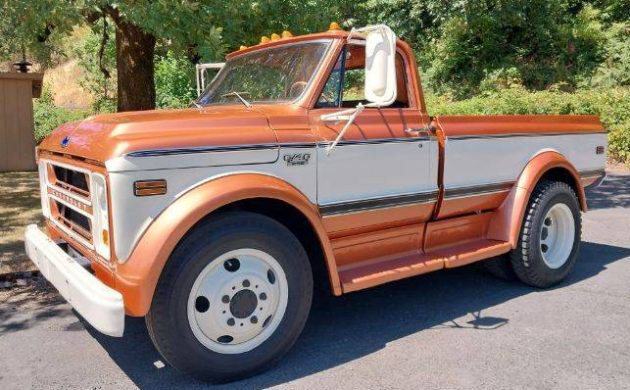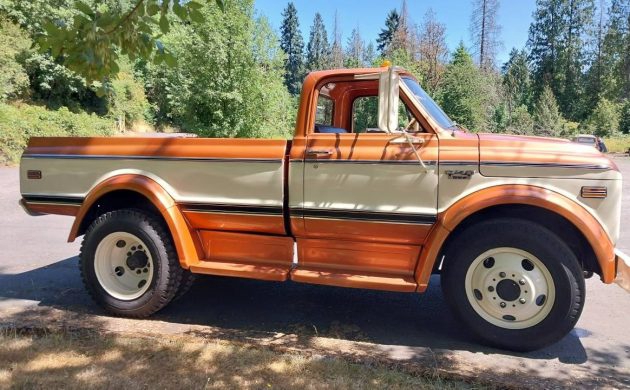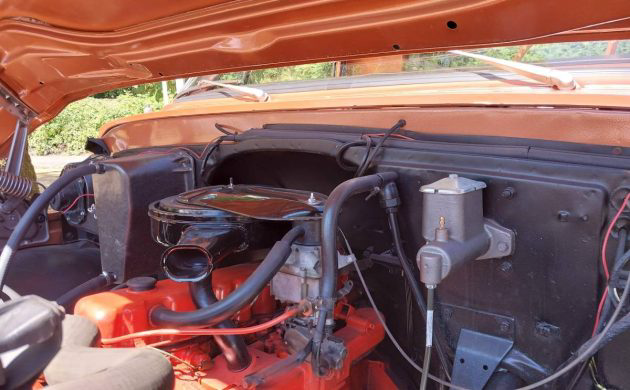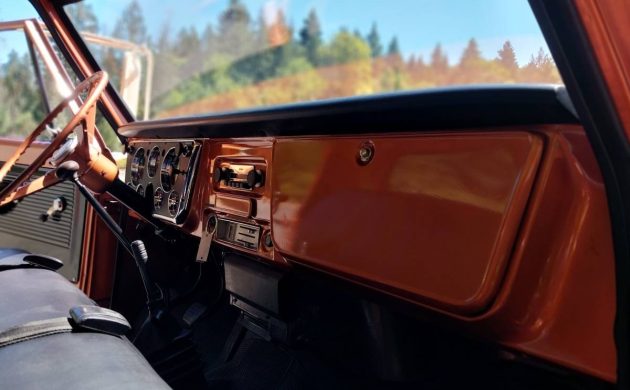One of the great attractions of the classic scene is the sheer diversity of machinery on offer if an enthusiast chooses to park something new in their garage. This 1970 Chevrolet C40 is a prime example because it is a stunning custom build that will turn heads, but it should be a low-maintenance alternative for those who want to spend their time behind the wheel having fun. The attention to detail is impressive, and I must say a big thank you to Barn Finder Matt H. for spotting this cool custom.
This C40 was part of Chevrolet’s Second Generation C/K Series that landed in showrooms for the 1967 model year. It is undeniably eye-catching, and it is hard to know exactly where to start with its custom touches. It started life as a farm truck with a stake bed, but the builder shortened the frame and added a modified C10 bed. By utilizing the front fender extensions and running boards from another C40, they gave the vehicle a purposeful appearance that also successfully covered the “dually” rear wheels. It was clever fabrication because by reversing the components and fitting the left-front extension to the right rear and vice versa, it creates a look that is almost “factory.” They massaged the exterior until it was arrow-straight before applying period-correct Chevrolet Copper Metallic paint with contrasting Ford Wimbledon White. The bed features a custom timber and aluminum floor, which is removable to expose a color-matched bed liner. The trim and glass are spotless, and this Pickup can’t help but draw crowds wherever it goes.
Lifting the hood reveals this Pickup’s original 292ci six, producing 170hp and 275 ft/lbs of torque. Chevrolet offered more potent options in 1970, but this engine’s low-end torque delivery made it ideal for a workhorse. The driver performs shifting duties with a four-speed manual transmission, and the first thing to note is that while this was a custom build, the entire drivetrain is numbers-matching. It is unclear whether the engine, transmission, or other mechanical components were refreshed during the build, but the new master cylinder suggests it received some TLC. The seller detailed everything to a high standard, with the engine bay presenting as it would have when the Pickup rolled off the line. It doesn’t flatter to deceive, with the seller describing the engine as being as smooth as “an antique Singer sewing machine.” That’s a phrase I’ve never heard when assessing any classic, but it confirms that this gem runs and drives well.
The seller followed a more conservative path with this C40’s interior, which isn’t as flamboyant as the exterior. However, they demonstrate an eye for detail and authenticity. They applied the same Copper Metallic that graces the exterior to the interior painted surfaces, fitting the original seat and floors with period-correct covers and mats. It appears the dash might feature a retro-style stereo, but it is hard to make a definite call. However, the presentation is as impressive as every other aspect of the vehicle. There is no visible wear or evidence of abuse, and the interior won’t cause the new owner shame if they hit the show circuit or rock up to a Cars & Coffee.
The seller listed this 1970 Chevrolet C40 Custom Pickup here on Craigslist in St. Helens, Oregon. They set their price at $33,000, raising the question of whether that figure is justified. That is a hard call to make because any modified classic writes its own rules. However, recreating this Pickup for that price would be almost impossible unless the builder was hands-on with almost every aspect of its fabrication and construction. It has only been on the market for a few days, and it will be fascinating to see how long it takes to find a new home. Are you tempted to make it yours?







would look right at home as a hot wheels car, because of the (sorta bloated) proportions and cool color scheme.
if i asked an artist to create a caricature of a old truck, this is what the artist would make.
good write up
Yes, a new master cylinder. But if you’re going to do that why not upgrade to a dual circuit unit with power assist?? This beast can’t be an easy thing to bring to a stop. And then there’s the safety factor.
It makes me wonder if the builder was very skilled at body and paint but out of his depth with mechanicals. What else is sub-par?
The power assist on these was under the cab, and also would be the dual master right after the power assist. the master you are seeing now only operated the power assist
Naturally, being a truck person, this is really cool. To a non-truck person? Not sure, but one thing is for sure, it’s well done. This was Chevys mid range entry to the truck world, similar to Fords F500 and I bet most became farm trucks. While the 6 may be a bit weak for today, it was fine for Farmer Brown. I’m a bit surprised at the single line brakes, and no 2 speed rear axle, double nickel is about all you’ll get, unless some sort of gearing update was done. Suspension too. Again, if nothing done in that regard, it will ride like a farm truck, shorter wheelbase only enhances the rough ride. Watch out for the “widow maker wheels” as well, I think, they look like 20″, and used to be, nobody offered a 5 bolt, tubeless wheel, but I see today, you can get them. I put up with that for a job, but didn’t want to be in a truck not working. It’s fun for about 20 minutes and I can only imagine the same here. If all that doesn’t bother you, it’s really cool.
What a cool looking truck, but with the 175hp 275tq motor its a complete slug. Bring it home and do a diesel swap.
This thing is unique, but at the same time a real widow maker! Locate a wrecked 2,500 diesel and swap the drivetrain.
everyone has their own taste…
Good luck with the sale… Creative for sure
Definitely gets a A for the uniqueness. But why leave that slug 6 banger in it? When they’re putting Chevy small blocks in everything from Porsches to Studebakers?
Do a Cummins swap. The Duramax/Allison would be “more authentic” being GM, but probably a lot more money unless one get’s a wreck for reasonable price. either would be better than the 292.
I’d love to see the look on the face of the driver of a jacked up, chrome wheeled, wide-tired, garbage can exhaust piped, smoke-spewing RAM pickup when this dude rolls up next to them at a stop light. In the world of “size matters” and “bigger is better”, this experience might lead to a certain sense of “deflation”…
The master cylinder usually operated a frame mounted vacuum assisted brake booster and some times a pair giving a dual system of sorts and in salty roads that’s a lot of brake lines.
Totally cool truck.
I am somewhat surprised that it has a 292ci. Most trucks in that C50 and C60 series, usually had a tall deck 366ci V-8 engine.
But the 292 was a smooth running engine, with gobs of low speed torque. Ideal for farm truck duty.
The single master cylinder probably is connected to a frame-mounted vacuum booster, so likely this truck has boosted brakes–however, a defect in any part of the brake system would ultimately cause loss of brakes, as there is currently only a single circuit. I agree that an upgrade to a dual master cylinder with a firewall mounted booster (either Hydro-Boost or an appropriate vacuum booster) and splitting the system into two circuits would give redundancy and a greater feeling of safety. The 292 was a great engine for a truck of this type. This truck wouldn’t be a road rocket, but I know from experience that this same truck with the vacuum-shifted two speed rear axle commonly found on these would readily keep up with traffic if driven enthusiastically (the two speed axle makes a world of difference.) This would be a great secondary road weekend cruiser. I love it!
After I thought about it, you( and Lincoln) are probably correct on the Hydro-Vac brakes. I drove several trucks that the owners were too cheap to upgrade the trucks to air brakes. Penny wise and dollar foolish. I had more scary rides in trucks with hydra-vac brakes than any other. In an application like this is probably adequate. Many seem to think a single line brake system is dangerous, I’m here to say not so. We, as a country, drove many miles for 75 years with single line brakes, and we’re all here today. While it’s true, in a situation where that 1 line is compromised, it can be tense, but no more than if any other part failed. With all the miles I have, I can only remember one time when juice brakes failed.
HydrO-vac, and for the record, most 2 speed rears by the 70s were electrically controlled.
I like what I see. It won’t be a road rocket but it will go down many roads. Back in the day I knew a couple of welders who did most of their work off-road. One was in such rough driving conditions that he was replacing the truck every year. A friend told him that he should advance from the 1-ton to the 1 1/2 ton and see how he liked it. He did just that and his truck/chassis platform lasted more than five years before the road salt got the best of it. By that time the chassis was pretty much finished so he just lifted the welder off and dropped it onto another C-40 and maintained that attitude until the newer models came out. He is still welding but now runs an IH CV (essentially a Chevy/GMC). The new truck rides a lot better but the cost of suspension repairs went up considerably…
Tums up!
Ridiculous.
For the record, Hydro-Boost uses the power steering pump to power the brake booster. These are quite powerful and relatively compact. Most school busses used this system in our area (as did many medium duty trucks). The dual master cylinder and Hydro-Boost assembly mounted on the firewall and included an accumulator in case the engine stalled. These were used widely with Diesels, also, since they don’t have manifold vacuum to tap. Over all, a very satisfactory system whether the truck had drum brakes, or the four wheel disk brakes that became universal in more recent mid-range trucks. I also agree that air brakes with spring-set parking brakes (“maxi-brakes”) are the favored system for higher GVW vehicles. I always preferred air brakes to hydraulics in the various trucks I drove through the years, just as a personal preference. As a fleet mechanic for a few years, I can attest to the fact that hydraulic brakes can experience partial or total failure, often due to rusted brake lines here in road salt country. Air brakes are far less susceptible to such failures.
I had to look that up, GOM, and on older trucks, I don’t remember any connection to the PS pump. In fact, I drove trucks with manual steering and a hydra-vac. It relied solely on engine vacuum, and one could easily “run out of vacuum” on those, making the pedal rock hard and no braking. I always found it odd it was called hydrO-vac, when hydro usually means anything with water. Hydra, short for hydraulic, would seem better, Geo? I believe what you are referring to is more modern hydroboost brakes, that do get vacuum from the PS pump somehow.
There’s been a lot of evolution in truck brakes. Harnessing engine vacuum is one of the oldest methods. Hydrovac is one of the oldest, which, as everyone knows, is a vacuum booster. A lot of single diesel trucks used a vacuum pump and reserve tank to keep from stopping like Fred Flintstone. Hydraboost was the next and utilized hydraulic oil from the steering system to assist application. Somewhere along that line they had to add an electric motor to pump oil should the steering pump fail. Air brakes are the simplest but, like everything else, they can fail and 80K lbs doesn’t stop on a dime…
You are absolutely correct that this truck was not new enough to have the system I described. I drove several anemic old trucks that didn’t have enough vacuum to feel really safe with a full load. The power steering pump powered system came somewhat later and was used by GM and Navistar, and possibly others, in their medium duty trucks, and especially school busses, since they all were dual circuit brakes and very safe. Chevy and GMC one tonners used this system, too, I believe. If the advertised vehicle was mine, I’d consider retrofitting the newer p/s powered booster, just to have that little extra margin of safety I our current litigious culture!